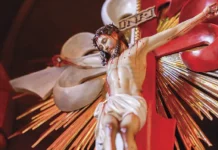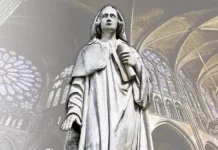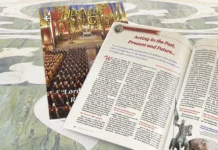I am inseparable from the Church; I serve as a shelter for precious objects, hear magnificent confidences, and collaborate in the carrying out of solemn ceremonies… Permit me to tell you my story.
When Jesus offered himself to His own at supper on Holy Thursday and the inhabitants of Heaven descended to earth to watch in amazement at the institution of the Sacrament of the Eucharist, the pledge of the Resurrection, I did not yet exist, although I was being conceived in the heart of the Holy Women who accompanied the Master (cf. Lk 23:48-56).
Some of the Apostles – very few – had a faint glimpse of me (cf. Lk 22:8-12). One of them, the traitor, would no doubt find me unnecessary, fearful perhaps that I would burden the common purse, for the earthly goods that approximate heavenly realities are generally costly. However, more than money, the making of such goods costs diligence and suffering.
It was while Christianity was spreading, still in the solitude and silence so characteristic of every work built upon solid foundations, that I planted my stakes in firm ground: in the souls of holy men, desirous of decorum and full of love for the Mass, already well known in the vast Roman Empire where I was born.

Traversing the centuries
When my walls began to appear, Constantine had already granted Catholics freedom of worship. My windows, initially small, with the passing of the centuries were eventually marked by art that was more angelic than human. I became tall and slender. I had reached my youth and was fine to behold.
In this historical period, Bishop Maurice De Sully1 envisioned me as part of an ensemble of perfect beauty. However, before the completion of the construction, he died. Many centuries later, an architect called Viollet-le-Duc,2 recognizing how necessary I am, restored me to my former splendour. A contemporary of his, Augustus Pugin,3 conceived me embellished with ornamentation. But they too were mortal and passed away. I, however, remain.
Other deceased have served as flooring for me. Under my footings are buried virtuous men who fought for God in anonymity, becoming as glorious in Heaven as they were far from glory in this world. Today they contemplate me with a smile from eternity. But here also lie famous figures for whom, though they were brilliant in the eyes of men, divine justice has reserved a different fate.
I have at times been able to attend councils,4 to witness accords and oaths, to hear the confidences of souls desirous of perfection, to see conversions, to record colloquia between men of this earth and the Blessed of Heaven. Countless are those who have found in me a harbinger of the heavenly homeland…
I have been used over the centuries by both those of the West and East, with their distinct customs, and to all I have been beneficial. Effectively, I have been an attentive spectator of history.
Witness of the intention of hearts
But, unfortunately, when my walls of solid masonry were already lined with plaster, paintings and fine decorations, I began, with aversion, to detect within them certain whispers, dissensions and, helás, conspiracies. Those who acted in this way wanted to disfigure the physiognomy of my mistress, and chose, I know not why, my premises for it.
Although I was indignant to harbour intruders in my sacred precinct, I could only keep silent, waiting for someone to cleanse the dust that degraded my beauty and the tarnish that obstructed the light of my eyes, the stained glass windows.
Meanwhile, I chose to admire the treasures that were entrusted to my keeping. The oils I store are holy: they have anointed unknown dying men as well as kings and Popes. The vestments I safeguard are a balm for the eyes and an ornament for the body. My inmost recesses are lined with the precious glow of sacred vessels; indeed, it is by virtue of these riches I have gained renown.

Preparing the world’s most august event
Nevertheless, my labour is daily: I am the one who receives the most important guests for the Banquet and provides them with everything necessary. Those who will be admitted by the Sovereign Host come to me, hoping to share in His dignity and honour.
After being suitably clothed, the guests form to recite a prayer, so as to worthily prepare their spirits to exercise their lofty ministry. At that moment, all eyes are turned to my monarchical point, the cross. In fact, I display the Crucified One to remind them that the nobility of my precinct is the fruit of a Redeemer.
Moreover, one of my walls supports an instrument that invites the presence of Angels and with which daily I announce the world’s most august event: the ringing of my bell is like a cry of alert and supplication raised from the Militant Church to the Church Triumphant. It is Mass that will begin.
In the meantime, everyone is silent, even myself. I can only contemplate the procession that passes… My function is fulfilled, my vocation, once again, shines .
Participant of a divine promise
Truly, I am the stage for both sorrows and glories.
Over the centuries – so often relentless in burying beauties – I have been visited, contemplated and perfected by men who have marked the Church’s history: Ambrose, Bishop of Milan; Gregory, the Great Pope; Bernard, Abbot of Clairvaux, St. Pius V, St. Pius X and so many others.
But today I am less visited, and therefore I confess my solitude.
However, the isolation does not sadden me. In the long moments of silence, I remember a Gospel episode that my walls portray, my stained-glass windows illustrate, the sound of my bell recalls, and my vessels do not fail to commemorate: “thou art Peter; and upon this rock I will build My Church, and the gates of hell shall not prevail against it” (Mt 16:18).
I have always believed in the divine words addressed by Jesus to the Sweet Christ on earth. Being part of the Church, I share in some way in that promise of immortality. As long as the gates of hell do not prevail over her – and this will never happen – I will be at her side.
I am perennial like the Church, I always remain close to her; I belong to and serve her. My name is: sacristy! ◊
Notes
1 Bishop Maurice de Sully (1120-1196). Bishop of Paris who initiated the construction of Notre-Dame Cathedral.
2 Eugene Viollet-le-Duc (1814-1879). French architect, renowned for the restoration of Notre-Dame Cathedral of Paris and other medieval edifices.
3 Augustus Welby Northmore Pugin (1812-1852). Using his very characteristic neo-Gothic style, he drew up the plans for the Parliament buildings of London and many churches.
4 For example, the Council of Carthage, held in 419 in my premises, in Basilica Fausti, at which two hundred and seventeen bishops were present (cf. RIGHETTI, Mario. Historia de la Liturgia. 2.ed. Madrid: BAC, 1955, v.I, p.442).













